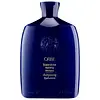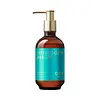What's inside
What's inside
 Key Ingredients
Key Ingredients

 Benefits
Benefits

 Concerns
Concerns

 Ingredients Side-by-side
Ingredients Side-by-side

Water
Skin ConditioningSodium Cocoyl Isethionate
CleansingSodium Lauroyl Methyl Isethionate
CleansingCocamide Mipa
EmulsifyingDimethicone
EmollientPropanediol
SolventPolyglyceryl-3 Laurate
EmulsifyingSodium Lauroyl Sarcosinate
CleansingPentylene Glycol
Skin ConditioningGlycerin
HumectantAcrylates/Beheneth-25 Methacrylate Copolymer
Parfum
MaskingGlycol Distearate
EmollientSodium Lauroamphoacetate
CleansingAmodimethicone
Sodium PCA
HumectantGuar Hydroxypropyltrimonium Chloride
Skin ConditioningSorbeth-230 Tetraoleate
EmulsifyingDivinyldimethicone/Dimethicone Copolymer
Caprylyl Glycol
EmollientSodium Benzoate
MaskingChlorphenesin
AntimicrobialPolyquaternium-113
Trisodium Ethylenediamine Disuccinate
Ethylhexylglycerin
Skin ConditioningPolyquaternium-7
Sodium Phytate
Quaternium-95
UV AbsorberDecyl Glucoside
CleansingPanthenol
Skin ConditioningVaccinium Macrocarpon Fruit Extract
AstringentSimmondsia Chinensis Seed Oil
EmollientLaureth-23
CleansingLaureth-4
EmulsifyingCetrimonium Chloride
AntimicrobialDimethiconol
EmollientTrideceth-15
EmulsifyingTrideceth-3
EmulsifyingSorbitan Laurate
EmulsifyingHydrolyzed Vegetable Protein
Skin ConditioningLauryl Glucoside
CleansingPhenoxyethanol
PreservativeFumaric Acid
BufferingRosmarinus Officinalis Leaf Extract
AntimicrobialC12-13 Alketh-23
CleansingC12-13 Alketh-3
EmulsifyingSalicylic Acid
MaskingCitrullus Lanatus Seed Oil
EmollientLitchi Chinensis Fruit Extract
Skin ConditioningVaccinium Macrocarpon Seed Oil
Skin ConditioningStearic Acid
CleansingLeontopodium Alpinum Flower/Leaf Extract
Skin ConditioningAcetic Acid
BufferingGlyceryl Caprylate
EmollientSodium Metabisulfite
AntioxidantCitric Acid
BufferingPentaerythrityl Tetra-Di-T-Butyl Hydroxyhydrocinnamate
AntioxidantPotassium Hydroxide
BufferingHexyl Cinnamal
PerfumingLimonene
PerfumingLinalool
PerfumingWater, Sodium Cocoyl Isethionate, Sodium Lauroyl Methyl Isethionate, Cocamide Mipa, Dimethicone, Propanediol, Polyglyceryl-3 Laurate, Sodium Lauroyl Sarcosinate, Pentylene Glycol, Glycerin, Acrylates/Beheneth-25 Methacrylate Copolymer, Parfum, Glycol Distearate, Sodium Lauroamphoacetate, Amodimethicone, Sodium PCA, Guar Hydroxypropyltrimonium Chloride, Sorbeth-230 Tetraoleate, Divinyldimethicone/Dimethicone Copolymer, Caprylyl Glycol, Sodium Benzoate, Chlorphenesin, Polyquaternium-113, Trisodium Ethylenediamine Disuccinate, Ethylhexylglycerin, Polyquaternium-7, Sodium Phytate, Quaternium-95, Decyl Glucoside, Panthenol, Vaccinium Macrocarpon Fruit Extract, Simmondsia Chinensis Seed Oil, Laureth-23, Laureth-4, Cetrimonium Chloride, Dimethiconol, Trideceth-15, Trideceth-3, Sorbitan Laurate, Hydrolyzed Vegetable Protein, Lauryl Glucoside, Phenoxyethanol, Fumaric Acid, Rosmarinus Officinalis Leaf Extract, C12-13 Alketh-23, C12-13 Alketh-3, Salicylic Acid, Citrullus Lanatus Seed Oil, Litchi Chinensis Fruit Extract, Vaccinium Macrocarpon Seed Oil, Stearic Acid, Leontopodium Alpinum Flower/Leaf Extract, Acetic Acid, Glyceryl Caprylate, Sodium Metabisulfite, Citric Acid, Pentaerythrityl Tetra-Di-T-Butyl Hydroxyhydrocinnamate, Potassium Hydroxide, Hexyl Cinnamal, Limonene, Linalool
Water
Skin ConditioningLauramidopropyl Betaine
CleansingSodium Lauroyl Methylalanine
Sodium Laureth-6 Carboxylate
CleansingTriethylhexanoin
MaskingCocamidopropyl Betaine
CleansingCocamide DEA
EmulsifyingPotassium Cocoyl Hydrolyzed Collagen
Skin ConditioningHydrogenated Argania Spinosa Kernel Oil
EmollientArgania Spinosa Kernel Oil
EmollientArgania Spinosa Callus Culture Extract
Skin ConditioningGamma-Docosalactone
Skin ConditioningDihydroxymethylsilylpropoxy Hydroxypropyl Hydrolyzed Casein
Skin ConditioningSodium Lauroyl Glutamate
Polyquaternium-64
Isostearoyl Hydrolyzed Keratin
CleansingGlyoxylic Acid
BufferingOpuntia Ficus-Indica Seed Oil
EmollientRosa Centifolia Flower Oil
MaskingMoringa Oleifera Seed Oil
EmollientMacadamia Ternifolia Seed Oil
EmollientOlea Europaea Fruit Oil
MaskingHydrolyzed Keratin
HumectantHematin
Diisostearyl Malate
EmollientPolyquaternium-47
Skin ConditioningPolyquaternium-53
Brassica Campestris/Aleurites Fordi Oil Copolymer
Skin ConditioningSphingolipids
EmollientPPG-3 Caprylyl Ether
SolventDimer Dilinoleyl Dimer Dilinoleate
EmollientZein
Skin ConditioningLanolin Acid
CleansingPolyquaternium-92
Hydroxypropyltrimonium Hyaluronate
Diethyl Sebacate
EmollientBis-Ethoxydiglycol Cyclohexane 1,4-Dicarboxylate
EmollientPotassium Cocoyl Glycinate
Guar Hydroxypropyltrimonium Chloride
Skin ConditioningPolyquaternium-50
Cyclopentasiloxane
EmollientIsomalt
HumectantLecithin
EmollientPolyquaternium-7
Polyquaternium-10
Isopentyldiol
HumectantGlycerin
HumectantEthylhexyl Pelargonate
Emollient1,2-Hexanediol
Skin ConditioningCaprylyl Glycol
EmollientButylene Glycol
HumectantSodium Chloride
MaskingPhytic Acid
Citric Acid
BufferingSodium Citrate
BufferingDecyl Glucoside
CleansingPolysorbate 80
EmulsifyingPotassium Cocoate
EmulsifyingPEG-160 Sorbitan Triisostearate
CleansingPentasodium Pentetate
Magnesium Nitrate
Magnesium Chloride
Sodium Carbonate
BufferingMethylisothiazolinone
PreservativeMethylchloroisothiazolinone
PreservativePentylene Glycol
Skin ConditioningSodium Benzoate
MaskingSilver Oxide
AntimicrobialDisodium EDTA
Dipropylene Glycol
HumectantTocopherol
AntioxidantPhenoxyethanol
PreservativeAlcohol
AntimicrobialParfum
MaskingWater, Lauramidopropyl Betaine, Sodium Lauroyl Methylalanine, Sodium Laureth-6 Carboxylate, Triethylhexanoin, Cocamidopropyl Betaine, Cocamide DEA, Potassium Cocoyl Hydrolyzed Collagen, Hydrogenated Argania Spinosa Kernel Oil, Argania Spinosa Kernel Oil, Argania Spinosa Callus Culture Extract, Gamma-Docosalactone, Dihydroxymethylsilylpropoxy Hydroxypropyl Hydrolyzed Casein, Sodium Lauroyl Glutamate, Polyquaternium-64, Isostearoyl Hydrolyzed Keratin, Glyoxylic Acid, Opuntia Ficus-Indica Seed Oil, Rosa Centifolia Flower Oil, Moringa Oleifera Seed Oil, Macadamia Ternifolia Seed Oil, Olea Europaea Fruit Oil, Hydrolyzed Keratin, Hematin, Diisostearyl Malate, Polyquaternium-47, Polyquaternium-53, Brassica Campestris/Aleurites Fordi Oil Copolymer, Sphingolipids, PPG-3 Caprylyl Ether, Dimer Dilinoleyl Dimer Dilinoleate, Zein, Lanolin Acid, Polyquaternium-92, Hydroxypropyltrimonium Hyaluronate, Diethyl Sebacate, Bis-Ethoxydiglycol Cyclohexane 1,4-Dicarboxylate, Potassium Cocoyl Glycinate, Guar Hydroxypropyltrimonium Chloride, Polyquaternium-50, Cyclopentasiloxane, Isomalt, Lecithin, Polyquaternium-7, Polyquaternium-10, Isopentyldiol, Glycerin, Ethylhexyl Pelargonate, 1,2-Hexanediol, Caprylyl Glycol, Butylene Glycol, Sodium Chloride, Phytic Acid, Citric Acid, Sodium Citrate, Decyl Glucoside, Polysorbate 80, Potassium Cocoate, PEG-160 Sorbitan Triisostearate, Pentasodium Pentetate, Magnesium Nitrate, Magnesium Chloride, Sodium Carbonate, Methylisothiazolinone, Methylchloroisothiazolinone, Pentylene Glycol, Sodium Benzoate, Silver Oxide, Disodium EDTA, Dipropylene Glycol, Tocopherol, Phenoxyethanol, Alcohol, Parfum
Ingredients Explained
These ingredients are found in both products.
Ingredients higher up in an ingredient list are typically present in a larger amount.
Caprylyl Glycol is a humectant and emollient, meaning it attracts and preserves moisture.
It is a common ingredient in many products, especially those designed to hydrate skin. The primary benefits are retaining moisture, skin softening, and promoting a healthy skin barrier.
Though Caprylyl Glycol is an alcohol derived from fatty acids, it is not the kind that can dry out skin.
This ingredient is also used as a preservative to extend the life of products. It has slight antimicrobial properties.
Learn more about Caprylyl GlycolCitric Acid is an alpha hydroxy acid (AHA) naturally found in citrus fruits like oranges, lemons, and limes.
Like other AHAs, citric acid can exfoliate skin by breaking down the bonds that hold dead skin cells together. This helps reveal smoother and brighter skin underneath.
However, this exfoliating effect only happens at high concentrations (20%) which can be hard to find in cosmetic products.
Due to this, citric acid is usually included in small amounts as a pH adjuster. This helps keep products slightly more acidic and compatible with skin's natural pH.
In skincare formulas, citric acid can:
While it can provide some skin benefits, research shows lactic acid and glycolic acid are generally more effective and less irritating exfoliants.
Most citric acid used in skincare today is made by fermenting sugars (usually from molasses). This synthetic version is identical to the natural citrus form but easier to stabilize and use in formulations.
Read more about some other popular AHA's here:
Learn more about Citric AcidDecyl Glucoside is a glucose-based surfactant and emulsion stabilizer. It is created by reacting glucose with the fatty acids from plants.
Surfactants help clean the skin by trapping oil, sebum, and dirt to be washed away. As an emulsion stabilizer, it stabilizes the ingredients in a product by preventing them from separating.
This ingredient is biodegradable and non-toxic. This ingredient is commonly found in baby shampoos.
Decyl Glucoside is sometimes used to stabilize the UV filter Tinosorb.
Learn more about Decyl GlucosideGlycerin is already naturally found in your skin. It helps moisturize and protect your skin.
A study from 2016 found glycerin to be more effective as a humectant than AHAs and hyaluronic acid.
As a humectant, it helps the skin stay hydrated by pulling moisture to your skin. The low molecular weight of glycerin allows it to pull moisture into the deeper layers of your skin.
Hydrated skin improves your skin barrier; Your skin barrier helps protect against irritants and bacteria.
Glycerin has also been found to have antimicrobial and antiviral properties. Due to these properties, glycerin is often used in wound and burn treatments.
In cosmetics, glycerin is usually derived from plants such as soybean or palm. However, it can also be sourced from animals, such as tallow or animal fat.
This ingredient is organic, colorless, odorless, and non-toxic.
Glycerin is the name for this ingredient in American English. British English uses Glycerol/Glycerine.
Learn more about GlycerinThis ingredient is derived from guar gum.
It is a conditioning ingredient, meaning it helps soften skin and hair.
Parfum is a catch-all term for an ingredient or more that is used to give a scent to products.
Also called "fragrance", this ingredient can be a blend of hundreds of chemicals or plant oils. This means every product with "fragrance" or "parfum" in the ingredients list is a different mixture.
For instance, Habanolide is a proprietary trade name for a specific aroma chemical. When used as a fragrance ingredient in cosmetics, most aroma chemicals fall under the broad labeling category of “FRAGRANCE” or “PARFUM” according to EU and US regulations.
The term 'parfum' or 'fragrance' is not regulated in many countries. In many cases, it is up to the brand to define this term.
For instance, many brands choose to label themselves as "fragrance-free" because they are not using synthetic fragrances. However, their products may still contain ingredients such as essential oils that are considered a fragrance by INCI standards.
One example is Calendula flower extract. Calendula is an essential oil that still imparts a scent or 'fragrance'.
Depending on the blend, the ingredients in the mixture can cause allergies and sensitivities on the skin. Some ingredients that are known EU allergens include linalool and citronellol.
Parfum can also be used to mask or cover an unpleasant scent.
The bottom line is: not all fragrances/parfum/ingredients are created equally. If you are worried about fragrances, we recommend taking a closer look at an ingredient. And of course, we always recommend speaking with a professional.
Learn more about ParfumPentylene glycol is typically used within a product to thicken it. It also adds a smooth, soft, and moisturizing feel to the product. It is naturally found in plants such as sugar beets.
The hydrophilic trait of Pentylene Glycol makes it a humectant. As a humectant, Pentylene Glycol helps draw moisture from the air to your skin. This can help keep your skin hydrated.
This property also makes Pentylene Glycol a great texture enhancer. It can also help thicken or stabilize a product.
Pentylene Glycol also acts as a mild preservative and helps to keep a product microbe-free.
Some people may experience mild eye and skin irritation from Pentylene Glycol. We always recommend speaking with a professional about using this ingredient in your routine.
Pentylene Glycol has a low molecular weight and is part of the 1,2-glycol family.
Learn more about Pentylene GlycolPhenoxyethanol is a preservative that has germicide, antimicrobial, and aromatic properties. Studies show that phenoxyethanol can prevent microbial growth. By itself, it has a scent that is similar to that of a rose.
It's often used in formulations along with Caprylyl Glycol to preserve the shelf life of products.
Polyquaternium-7 is a light to clear colored liquid. It is commonly found in haircare products for its film-forming and anti-static properties.
According to a manufacturer, it is a non-paraben and specially developed for negatively charged surfactant systems. This makes it a great hairstyle holder and helps to improve wet hair detangling without adding buildup.
Sodium Benzoate is a preservative. It's used in both cosmetic and food products to inhibit the growth of mold and bacteria. It is typically produced synthetically.
Both the US FDA and EU Health Committee have approved the use of sodium benzoate. In the US, levels of 0.1% (of the total product) are allowed.
Sodium benzoate works as a preservative by inhibiting the growth of bacteria inside of cells. It prevents the cell from fermenting a type of sugar using an enzyme called phosphofructokinase.
It is the salt of benzoic acid. Foods containing sodium benzoate include soda, salad dressings, condiments, fruit juices, wines, and snack foods.
Studies for using ascorbic acid and sodium benzoate in cosmetics are lacking, especially in skincare routines with multiple steps.
We always recommend speaking with a professional, such as a dermatologist, if you have any concerns.
Learn more about Sodium BenzoateWater. It's the most common cosmetic ingredient of all. You'll usually see it at the top of ingredient lists, meaning that it makes up the largest part of the product.
So why is it so popular? Water most often acts as a solvent - this means that it helps dissolve other ingredients into the formulation.
You'll also recognize water as that liquid we all need to stay alive. If you see this, drink a glass of water. Stay hydrated!
Learn more about Water